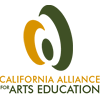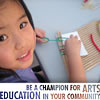Are Public-Private Partnerships the Way Forward?
In recent years, the Pasadena Unified School District (PUSD) has put together an innovative program called My Masterpieces: Discovering Art in My Community, which capitalizes on local art institutions through field trips and specifically co-designed K-6 visual art curriculum. With California facing a fiscal meltdown and harrowing cycles of budget cuts, we wondered if these kinds of public-private models offer a viable way to build sustainable arts education programs. We spoke with Marshall Ayers, the Arts Education Coordinator for the district, to learn more.
Alliance: Were there existing relationships with local art institutions before the partnership?
MA: There were long-standing relationships with many of the local institutions. But the programs varied from school to school, depending on if there was a strong interest among parents or an individual principal. We had students accessing some cultural institutions, but it was in a more or less random manner. We hoped curriculum based partnerships could address issues of equity and access.
Alliance: How did the partnerships get started?
MA: At a recent training for arts coordinators, evaluator Lynn Waldorf said, “When you don’t have money, it’s a good time to plan.” And that really proved to be true for us.
It began with the launch for the Arts for All initiative. PUSD became an Arts for all District in 2004 and that started the process of developing our arts plan as well as a district arts team and a community arts team. At the same time, the city was undergoing a cultural strategic planning process. That meant most of those arts partners were already around our table. Later, when block grant funds or other private funding became available, we were ready with a plan.
Alliance: How did having all those entities involved affect the planning process?
MA: I think it really helped to have all the stakeholders at the table. We began with a feasibility study prepared by the senior author on the project Jennifer Olson. The study looked at how this community could provide field trips embedded in curricular connections using the cultural resources that were already here. There was talk about a unique Pasadena curriculum because of the collections here in the city. We tried to capitalize on what we saw as permanent fixtures.
Previously, art institutions had been trying to build relationships and programs with the school district with varying degrees of success Now they were around a table with PUSD teachers who knew the core content standards, and could say ‘Here’s how this could work for us.”
Alliance: Can you give an example?
MA: Well, we are an Open Court district and in second grade one of the unit themes is “Heroes.” So we bring 2nd grade to City Hall where they take part in a public art walking tour that includes the Pasadena Robinson Memorial. It just made sense to for teachers who are already studying heroes, who may already be using Jackie and Mack Robinson in their lessons, to do a classroom art lesson where students then create their own sculptural hero portraits. The next time they drive by those sculptures, those 2nd graders are really going to remember that lesson.
Alliance: What were some of the ideas that came from local institutions?
MA: Museum educators were interested in return visits, so we built free family passes into the program. They appreciated that it’s about civic engagement and audience development. The idea that starting in kindergarten, PUSD students’ feet would have passed through each one of these institutions by the time they finished 6th grade. It’s a win win.
Another need we identified was for museum staff to be educated about who our students are, so they can think about how to work with specific school populations. Together, we identified the places where their institution might already be aligned with certain ages and grades. Instead of trying to serve every grade level programmatically, we suggested that perhaps institutions could adopt an entire single grade level – taking a horizontal rather than vertical approach.
Alliance: As you’ve mentioned Pasadena has such amazing cultural resources. Do you think the program can be applied in other districts?
MA: It’s hard to say because we designed it specifically for this community. But I think most communities have individual artists, or assets or people or places that they could, if they looked at it through this lens, build a similar kind of curriculum. It might not be around visual art, it might be around music, dance or theater. This model could also apply to other subject matters like science or math. The important thing is to play to your strengths.
For more information about the PUSD program, click here
*Ed. note: In 2004, the Alliance guided the development of the district wide arts plan in Pasadena Unified utilizing our Insider’s Guide to Arts Education Planning.










